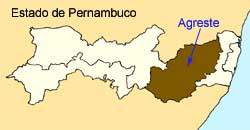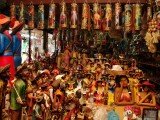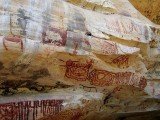Este post também está disponível em:
Português
English

The Agreste is the intermediate region in the interior of Pernambuco between the Mata and the Sertão.
The agreste is characterised by a diversified economy, with the cultivation of crops such as corn, beans, cassava, among others, and dairy and beef cattle.
The main dairy basin of the state, Agreste has higher rainfall rates than Sertão, with an annual average between 800 and 1000 millimetres, but it is also a region subject to periodic droughts.
It is divided into six micro-regions, which we will see below: Vale do Ipanema, Vale do Ipojuca, Alto Capibaribe, Médio Capibaribe, Garanhuns and Brejo Pernambucano. It generally has shallow, eroded and depleted soils and is suitable for growing cereals.
Mild climate, forest trails, waterfall bathing, natural pools. These are some of the attractions of Agreste de Pernambuco for tourists who are looking for adventure and leisure.
Tourist spots in Agreste of Pernambuco

1. City of Caruaru
Caruaru is considered the capital of the Pernambuco agreste and located 132 kilometres from Recife, Caruaru disputes with Campina Grande, in Paraíba, the title of host of the largest Brazilian festival of São João.
It is true that the city in Paraíba attracts the largest number of people on 24 June, but in Caruaru the festival lasts longer: it always starts on the first weekend of June and ends a month later.
The headquarters of the celebrations is the Pátio de Eventos Luiz Lua Gonzaga, located outside the Espaço Cultural Tancredo Neves. There, the Vila do Forró was installed, which reproduces a typical country village during the June festivities.
Quadrilhas, violeiros and repentistas take over the streets of Caruaru during the festivities, which include the “bacamarteiros”: continuing an old tradition, wielding their bacamartes – an ancient firearm with a short, wide barrel – they perform to the sound of xaxados played by an orchestra composed of accordions, triangles, zabumbas and pífanos.
Caruaru has the largest free market in the Northeast and the Casa do Mestre Vitalino Museum, which honours one of his most famous sons. Those coming from Recife can reach Caruaru via the BR-232 motorway, which has been duplicated and is in good condition. From Campina Grande, access is via BR-104.
1.1. Feira de Caruaru

Handicrafts and benzedeiras, medicinal herbs and typical foods, passing through electronic products.
These are some of the offerings of this fair, set up in the 150,000 square metres of Parque 18 de Maio.
On Saturdays, it is open only as a free market and a craft fair, and it gets so crowded that you can hardly walk around. Research a lot before buying: the variation in prices is unbelievable.
Monday is the day of the Feira da Sulanca – in local parlance, clothes made by small clothing manufacturers – where traders from other cities come to Caruaru in search of cheap goods for resale. Parque 18 de Maio, s/n, Centre
1.2. Alto do Moura in Caruaru
The Alto do Moura neighbourhood, 7 kilometres from the centre of Caruaru, concentrates the studios of most of the city’s artisans. One of them is Severino Vitalino, son of Master Vitalino (Vitalino Pereira da Silva, 1909-63), a historic name in Brazilian handicrafts.
The residence that the artist himself built in 1959 was transformed in 1971 into the Casa do Mestre Vitalino Museum, managed by Severino.
The museum brings together pieces by the master – which, unlike the works made by his son and followers, are not for sale – as well as personal objects (Rua Mestre Vitalino, s/n).
1.3. Museu do Barro and Museu do Fórro

The Tancredo Neves Cultural Space, inaugurated in 1988, is located in a former caroa processing factory on an area of 49,500 square metres.
There are two of the most important museums in Caruaru: the Clay Museum, named after Master Zé Caboclo, and the Forró Museum, named after Luiz Gonzaga.
On the first floor of block B, the collection of the Zé Caboclo Clay Museum consists of 2,300 pieces, making it one of the most important institutions of its kind in the whole country.
The material is distributed in five environments. In the Alto do Moura Ceramists Room, the works of the main artisans of the neighbourhood are on display – except for those of Mestre Vitalino, whose production was given its own space, with 67 pieces; among them, “O homem e o galo maracajá”, considered his first major work.
The Abelardo Rodrigues Collection includes important pieces from other northeastern handicraft centres, such as Tracunhaém, Petrolina and Goiana.
The museum also houses the Temporary Exhibitions and Educational Activities Room and the Luísa Cavalcanti Maciel Painting Gallery.
On the ground floor of the same block is the Luiz Gonzaga Forró Museum. In three rooms, a valuable collection on the life and career of the so-called “King of Baião” is distributed.
Although he was born in the Pernambuco town of Exu, he is considered one of the greatest promoters of Caruarense culture. The museum that honours him brings together photos, musical instruments, clothes and, of course, records.
The following rooms are dedicated to the June festivities of the “Capital of Forró” and, in an annexed area, the Elba Ramalho Space was set up, with costumes and objects of the singer – who, incidentally, was born in Paraíba. Praҫa Cel. José Vasconcellos, 100, block B, Centre.
1.4. Morro do Bom Jesus
Caruaru rises around this 630-metre-high hill, on the top of which are viewpoints, radio station transmitters and a chapel, originally called Capela do Socorro and later named Capela do Bom Jesus by the diocese.
From one of the viewpoints, you can see the Caruaru Fair and the Maurício de Nassau neighbourhood, the noblest in the city.
2. Catimbau National Park

.
The Parque Nacional do Catimbau was opened in 2002, little explored and still without any infrastructure, this park is in the Catimbau valley, surrounded by the mountains of Buíque, a city 25 kilometres away from Arcoverde.
The vegetation of the area, in the transition between the agreste and the sertão, comprises caatinga, Atlantic forest, rupestrian field and cerrado and is home to about 150 species of birds, including the goldfinch, endemic to the Northeast.
Its great attractions are the geological formations, exuberantly sculpted by time, and the rock inscriptions. The rock barriers make up drawings in red, yellow and blue – there is nothing similar in any other conservation unit in Brazil.
The second largest archaeological site in the country, Alcobaça, is located in the Catimbau National Park. Although water is scarce, it is possible to cool off in the Wild Paradise, a spring that forms a spa with natural pools.
The 62,300 hectares of Catimbau can be explored both by hiking and in four-wheel drive vehicles; however, it is mandatory to be accompanied by monitors from the local guides association.
Access to the park is via the BR-232 motorway to the municipality of Arcoverde and then the PE-076 motorway to Buíque. Both roads are in very poor condition.
3. City of Bezerros
Bezerros is situated between Caruaru and Gravatá – 27 kilometres from the former and 20 km from the latter – Bezerros, in the agreste of Pernambuco, at kilometre 107 of the BR-232, is synonymous with woodcutting and papangus.
In the first technique, the major reference is the important woodcutter J. Borges, while Lula Vassoureiro stands out among those who produce the famous coloured masks with newspaper, a hallmark of the city’s carnival revelry.
Handicrafts are thus a kind of business card for Bezerros. It is worth visiting the workshops of the artists mentioned, as well as the headquarters of the Association of Artisans, which has a good range of pieces on offer.
The hike up to the Serra Negra, in turn, can be a doubly pleasant programme: for the landscape itself and to get to know the Cultural Pole.
3.1. José Borges Memorial
José Borges – internationally known as J. Borges – was born in Bezerros more than seventy years ago and is responsible for the fame of wood engraving.
The artisan is still active, although today production is slowing down due to his health and, above all, the series of trips he makes to fulfil commitments, especially abroad.
In this memorial – actually a workshop – Mr Borges receives visitors, makes his pieces and teaches what he knows to his children and a grandson. Av. Major Aprígio da Fonseca, 420, Centre.
3.2. Cultural Centre of Serra Negra
In the village of Serra Negra, 10 kilometres from the centre of Bezerros, is the Cultural Pole, a concrete structure that contrasts with the surrounding green forest.
At the top of the mountain, the view is particularly privileged and the trails are much sought after by visitors and locals.
In the beautiful amphitheatre, built in the open air, there are regular shows and music concerts. Vila de Serra Negra, s/n, Zona Rural.
3.3. Association of Artisans
One of the best places to buy handicrafts produced in Bezerros, the organisation operates in a building provided by the city hall, which allows artisans to sell their work for lower prices.
In addition to papangus masks, there are also wooden and fabric ones. Rua Vigário Manuel Clemente, 123, Centre.
3.4. Centro de Artesanato de Pernambuco
A mix of museum, workshop and shop, this centre rivals others of its kind located in major cities in the northeast.
The museum displays items from almost every craft-producing municipality in the state. In the workshop, participants learn to work with woodcuts and make masks. In the shop, tourists can find pieces from various regions of Pernambuco. Av. Major Aprígio da Fonseca, 770, km 107 of BR-232, São Sebastião.
3.5. Tradition of the Papangus

When, at the beginning of the 20th century, the revellers of Bezerros began to take to the streets with masks made of paper from wrapping jerky and cardboard painted with fava leaves, it became customary to present them with fruit, eggs, beiju and chicken.
Over time, the masks have improved – today they have a plaster mould, are made of newspaper and painted with oil paint – and the offering made to the masked people has changed: the residents visited started to serve angu. It didn’t take long for the name to catch on: papangu.
A traditional feature of Bezerros Carnival, the masks made by Lula Vassoureiro take over the streets of the city during the days of revelry.
In Vassoureiro’s workshop, you can buy not only papangus and their matrices, but also dolls and other pieces made from the same material as the masks. Rua Otávia Bezerra Vila Nova, 64, Santo Amaro 1.
4. City of Gravatá
Rising 447 metres above sea level, with an average annual temperature of 21°C and full of restaurants serving fondue, Gravatá, 80 kilometres from Recife on the BR-232 highway, is known as the “Switzerland of the Northeast”.
The “European” climate coexists without crisis with Brazilian traditions – its June festivities attract many tourists, as does the Festa da Estação, held in August to mark the end of the so-called Cold Circuit.
Four other municipalities – Garanhuns, Pesqueira, Triunfo and Taquaritinga in the agreste of Pernambuco – are taking part in the event, which is promoted by the state government and includes workshops, lectures and musical performances (Pátio de Eventos Chuchre Mussa Zazar, av. Joaquim Didier, s/n, Centro).
The September Festival, promoted by the sectors that support the city’s economy – furniture, gastronomy, handicrafts and flower production – brings together, in 1500 square metres of stands, what Gravatá does best.
4.1. Craftsman Station
The station, so called because it is located in the city’s old railway station, is run by the Gravatá Artisans Association and has the support of the city hall. It displays the work of approximately sixty artisans.
The space is divided into two rooms where you can find wooden pieces and fabrics and canvases by local artists. Rua João Pessoa, s/n, Centre.
4.2. Morro do Cruzeiro
Walking through Gravatá, wherever you look, you can see the replica of Christ the Redeemer standing on top of the Cruzeiro hill with his arms open over the city.
Inaugurated in July 1941, the monument is 7 metres high by 8 metres at its base. It is a five-minute drive from Santana church.
You can also take the Staircase of Happiness – which has 365 steps – from the foot of the hill, a journey that takes about 15 minutes.
From the highest point of Gravatá, the view is extraordinary, especially at sunset! In addition to the Christ, at the top of the hill there is a restaurant and a radio station.
4.3. Furniture Pole
Sixty furniture and wood decoration shops are located in the centre. There are also handicrafts. The articles are not limited to local production; pieces produced in various regions of the Northeast can be found. Rua Duarte Coelho
5. City of Garanhuns
Located 230 kilometres from Recife, Garanhuns in the agreste of Pernambuco, with an average annual temperature of 21°C, became nationally known for being the birthplace of Luiz Inácio Lula da Silva, actually born in Caetés, then a district of this municipality.
However, more than the birthplace of the labour leader who became President of the Republic, it is the largest mountain city in the Northeast and home to a Winter Festival that has been attracting attention even in other regions of the country; in addition, Garanhuns maintains within its limits a community of descendants of quilombolas, Castainho, a remnant of the Quilombo dos Palmares.
From the top of the Cristo Magano hill you can enjoy the best view of the city, whose postcard is the 4-metre-diameter flower clock (Praҫa Tavares Correa, at the beginning of Av. Rui Barbosa).
From the capital of Pernambuco, Garanhuns can be reached by the BR-232 motorway up to km 150 (São Caetano) and then by the BR-423 motorway.
5.1. Winter Festival
Held for fifteen years during the July holidays, it is one of the main events in the tourist calendar of Pernambuco.
For ten days, presentations of artists and workshops in the areas of visual arts, dance, literature, fashion, heritage, music and theatre are promoted in various parts of the city.
Since 2001, the community of Castainho has been part of the programme of the event, organised by the Department of Education and Culture of the State of Pernambuco / Fundarpe in partnership with the city of Garanhuns.
6. City of Fazenda Nova
Since it became home to the Nova Jerusalem theatre city 37 years ago, Fazenda Nova, 187 kilometres from Recife, has gained international notoriety.
The largest open-air theatre on the planet is 100,000 square metres – equivalent to a third of the walled area of the original Jerusalem, where Jesus lived.
Another attraction in the city is the Nilo Coelho Monumental Sculpture Park, a 60-hectare space where 37 granite sculptures are displayed, some up to 2 metres high, representing the culture of the Northeast in its different aspects – religious, musical, folklore, etc. Rua Antonio Lupe, s/n.
7. Passion of Christ in New Jerusalem
In 1951, businessman Epaminondas Mendonça had the idea of staging the Passion of Christ in the streets of Fazenda Nova.
The project to build a replica of the Jerusalem of Christ’s time came up with journalist Plínio Pacheco, who arrived in the city in 1956; however, the first presentation in the new setting would only take place in ‘1968.
Since then, the Passion of Christ, every year, between the Saturday before Palm Sunday and Hallelujah Saturday, an audience of about 8,000 people watches the staging of the best-known story of the West on nine gigantic stages.
With the aid of the latest technological effects, 500 actors – some well-known from TV – work for two and a half hours, accompanied by the huge audience that ends up acting as supporting actors in the Passion of Christ.
The most popular session is undoubtedly the Friday of the Passion.
Agreste de Pernambuco Tourism and Travel Guide






















